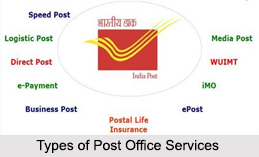 The Department of Posts, currently traded as the India Post has a vast network of post offices and aims to generate revenues by introducing a number of business products and services. Discussed elaborately below are the various types of Indian Post Office services:
The Department of Posts, currently traded as the India Post has a vast network of post offices and aims to generate revenues by introducing a number of business products and services. Discussed elaborately below are the various types of Indian Post Office services:
Speed Post
Started in August 1986, the Speed Post provides a time- bound and express delivery of letters and parcels weighing up to 35 kg between specified stations within the country. With a monthly volume of more than 4 crore articles, Speed Post is the market leader in the domestic express industry and the flagship product of the Department of Posts. In some metropolitan cities, round the clock Speed Post booking facility is available. The service also provides insurance and compensation in case of misplacement of the Speed Post article.
Business Post
Introduced in 1996 by the Department of Posts, the Business Post service offers a comprehensive solution to corporate or government organizations and other corporate houses for their pre- mailing requirements. Business Post services are available in Business Post Centre at major post offices across the country. The services include home or office collection, insertion, sealing, addressing, franking, special handling, etc, which are required to be completed before an article is posted.
Direct Post
With an increased commercial activity in India, the business organizations" need for direct advertising of products and services has grown exponentially. For direct advertising, Direct Mail is the most potent medium. Direct Mail is basically a printed matter usually carrying a sales message or announcement designed to elicit a response from a carefully selected consumer or business market.
Direct Post is the un- addressed component of Direct Mail in India. It comprises of un-addressed postal articles like letters, cards, brochures, questionnaires, pamphlets, samples and promotional items like CDs, coupons, posters, mailers or any other form of printed communication that is not prohibited by the Indian Post Office Act, 1898 or Indian Post Office Rules, 1933.
Media Post
The Media Post is a unique media concept by the India Post to help the corporate and government organizations reach potential customers. No other medium can match the sheer expanse of India Post in terms of volume and reach. And Media Post offers a range of advertising mediums such as postal stationery, postal premises etc.
Logistics Post
Offering the customers a range of integrated logistics and fulfilment services, the Logistics Post can be made accordingly suiting the customer"s needs. Logistics Post manages the entire distribution chain of the logistics customer from collection to distribution, from storage to carriage and from order preparation to order fulfilment. The distribution task is made effectively easy for the customers and since there is no maximum weight limit for the article, the minimum weight limit is 50 kg.
For Logistics Post, the India Post has started utilizing flights of Air India for providing airlift to parcels and these consignments has been provided between the cities of Agartala, Delhi, Mumbai, Kolkata, Nagpur, Bengaluru, Hyderabad, Chennai, Pune, Ahmedabad, Imphal, Guwahati, Patna, Lucknow and Thiruvanathapuram.
E-Post
Providing electronic transmission of messages, currently the E-Post booking facility is available in more than 13, 400 post offices and physical delivery through a network of more than 1.54 lakh post offices across India. The E-Post service is provided for both retail as well as corporate customers. The corporate services provided by E-Post enables corporate consumers including government departments, Public Sector Units, SMEs or Small and Medium Enterprises, companies, etc. to draft, design and send the messages as per their business requirements from their office premises by using internet.
Other modes of electronic services of the Indian Postal Service include E-Post Office and E-IPO also known as Electronic Indian Postal Order.















